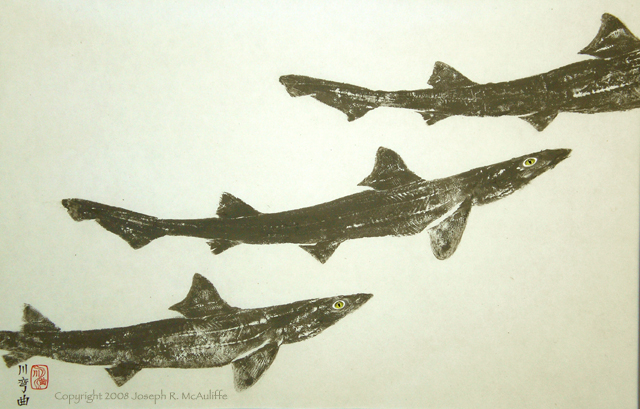
The inked impressions of this sleek little shark provide a lesson in fish anatomy that is more than skin-deep. A fish’s flesh is composed of a repeating series of thin muscular segments called myomeres. When cooked, adjacent myomeres tend to separate, giving the flesh of many fish their prized “flaky” texture. Sharp bends in a myomere give its outside surface beneath the skin the shape of an irregular letter “W” standing on end. The repeating pattern of the “W”-shaped segments reveals itself clearly below the anterior dorsal fin (large fin on top) of the middle fish.
Muscle fibers within each myomere point from the fish’s head to tail. When muscle fibers contract, they shorten, slightly bending the head and tail toward the side of the body where the contraction occurred. This bending stretches or relaxes the muscles on the other side of the body. In this manner, sets of myomeres on the two sides of a fish’s body act as opposing muscles much in the way as the biceps and triceps of your upper arm. Contract your biceps and you raise your lower arm and simultaneously stretch or relax the triceps. Contract the triceps to lower your arm and relax the biceps. In a fish, alternate waves of contractions of myomeres on one side of the body, then the other, starting at the head and moving toward the tail provides the gracefully undulating movement ending with a flap of the tail. These waves of myomere contractions from head to tail in a swimming fish range from a low, steady beat of about 5 per minute in larger sharks to a frenzied high of 170 per minute in small, swift-swimming mackerel.
Sharks, unlike many bony fishes, do not have internal, gas-filled air bladders to make them neutrally buoyant in water. This lack is partially offset by large, paired pectoral fins (on the side, directly behind the head) that tilt upward, lifting the shark as it swims forward. However, to keep from slowly, steadily sinking, sharks that live in open water must keep moving. Most sharks also must keep moving constantly in order to keep oxygen-bearing water circulating over their gills. The tails of most sharks are asymmetrical with longer upper edges. Side-to-side beats of the top-heavy tail directs some of the thrust downward, slightly lifting the tail end, keeping it in horizontal plane with the front end that is lifted by the pectoral fins.
Size: 36 x 24 inches (2001)
Return to Gallery 2.